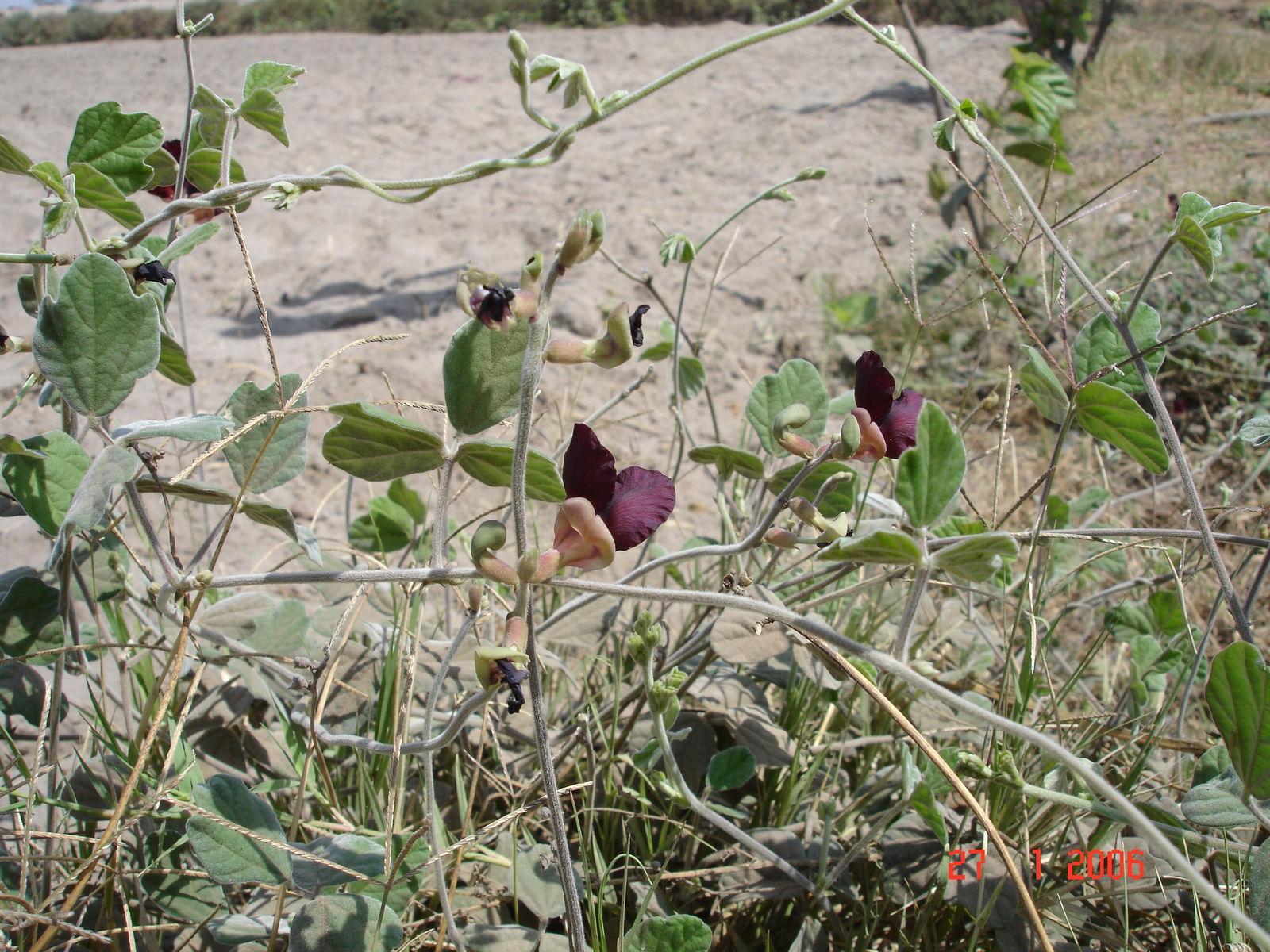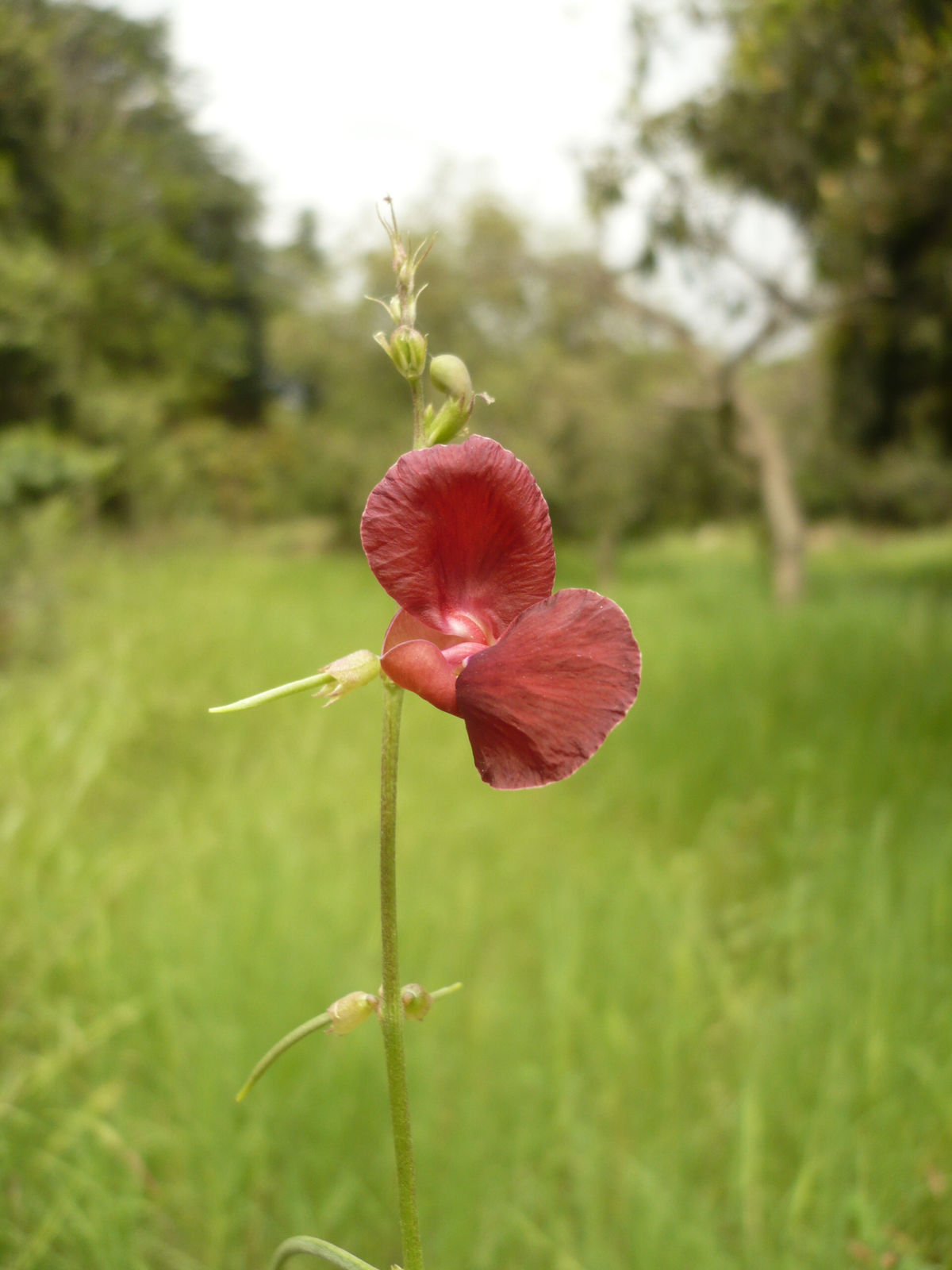Purple-flowered bush bean
macroptilium lathyroides
Also known as: ["Bush bean","Purple-flowered bean"]
Overview
A leguminous plant with purple flowers, often used as a cover crop or forage plant.
Benefits & Perks
["drought tolerant","wildlife attractant (bees, butterflies, birds)"]
Botanical Classification
| Phylum: | Magnoliophyta |
| Class: | Magnoliopsida |
| Order: | Fabales |
| Family: | Fabaceae |
| Genus: | Macroptilium |
| Botanical Name: | Macroptilium lathyroides |
Plant Characteristics
Basic Information
- Category: Flowers
- Suitable Location: garden bed or container in a sunny spot
- Suitable For:
- Is Weed: No
- Allergenicity: low
Environmental Needs
- Climate: {"temperatureRange":"10–35°C"}
- Hardiness: {"zones":"8–11"}
- Misting: rarely required, only if ambient humidity is very low
- Drainage: Fast-draining to prevent root rot.
- Soil Type: Well-draining, loamy soil with added organic matter.
Maintenance Level
- Maintenance Level: moderate
- Toughness Level: moderate
- Pruning Frequency: Light pruning every 2–3 months; heavy pruning annually after flowering.
- Pruning Intensity: Moderate; remove up to one-third of growth if needed to rejuvenate.
Care Details
Ideal Sunlight Coverage:
Full sun (6–8 hours/day); tolerates partial shade but may flower less.
Sunlight Tolerance Tips:
Acclimate new plants to full sun gradually over 1–2 weeks; protect from intense midday sun in hot climates; ensure good air circulation to prevent sunburn.
Care Requirements
Care Difficulty
easyeasy
Sunlight
full sun to partial shade
Rotate plant weekly for even growth; use sheer curtains in intense sun; avoid sudden light changes.
Watering
every 7–10 days during active growth, reduce in winter
Water thoroughly until it drains from the bottom, allow soil to dry between waterings, avoid overhead watering to prevent fungal issues.
Soil
well-draining, loamy soil with moderate organic matter
pH: Slightly acidic to neutral (pH 6.0–7.0).
Use a mix of potting soil and perlite; avoid heavy clay soils; ensure pots have drainage holes.
Temperature
Prefers 65–85°F (18–29°C); can tolerate light frost but thrives in warm conditions.
Avoid sudden temperature shifts; protect from drafts; maintain consistent warmth for best growth.
Fertilizing
every 4–6 weeks during growing season
Apply fertilizer after watering to prevent root burn; flush soil occasionally to prevent salt buildup; reduce feeding in dormancy.
Propagation
Methods
Stem cuttings or seed; stem cuttings root easily in warm conditions.
Step-by-Step Propagation Guide
- Take a 4–6 inch cutting, remove lower leaves, dip in hormone (optional), plant in medium, keep moist and warm.
Best Time: Spring or early summer when the plant is actively growing.
Environment
Warm (70–75°F), high humidity (70–80%), indirect light.
Medium
Well-draining mix like perlite and peat moss or cactus mix.
Hormone
Optional but recommended for faster rooting.
Timeline
Roots develop in 2–4 weeks; new growth appears in 6–8 weeks.
Tools Needed
Pruners, rooting hormone, small pots, well-draining medium.
Quick Tips
Use healthy, non-flowering stems; maintain consistent moisture; provide bottom heat for faster rooting.
Pruning & Repotting
Pruning Guide
Method
Pinch back tips for bushiness; cut back stems to a leaf node or lateral branch.
Pruning Plan
Remove dead or leggy growth to encourage bushier habit and more blooms.
Tools
Clean pruners or scissors, disinfectant.
Checklist
Sanitize tools, prune dead/damaged growth, shape plant, avoid over-pruning.
Repotting Guide
Best Season
Spring, before new growth begins.
Pot Size
One size larger pot; ensure it has drainage holes.
Method
Remove plant gently, trim roots if needed, place in fresh soil with good drainage, water lightly.
Suggestions
Repot every 2–3 years or when roots fill the pot; beneficial for growth and flowering.
Checklist
Choose right pot, prepare fresh soil, handle roots carefully, water after repotting.
Advanced Care Tips
Watering Mastery
Watering Checklist
Check soil moisture, water thoroughly, ensure drainage, avoid wetting foliage.
How to Apply Water Properly
Water directly at the root zone, apply until water drains from the bottom, ensure excess water exits the pot, water in the morning to reduce evaporation and fungal risk.
Watering Schedule Tips
Water deeply once the top inch of soil feels dry; reduce frequency in winter to prevent root rot.
Soil Improvement
Add perlite or sand for drainage; incorporate compost for fertility; ensure good aeration.
Temperature Stress Management
Signs of Temperature Issues
Wilting, yellowing leaves, stunted growth, or bud drop in extreme heat or cold.
Cold Stress
Slows growth, may cause leaf drop or dieback in prolonged cold; roots are susceptible to freezing.
Solution: Move to a sheltered location, provide frost protection, avoid overwatering in cold conditions.
Hot Stress
Leaves may wilt, curl, or scorch; flowering may be reduced in extreme heat.
Solution: Provide shade during peak heat, increase humidity, water more frequently but avoid waterlogging.
Fertilizing Guide
Fertilizing Checklist
Check fertilizer type, dilute correctly, apply during active growth, avoid winter feeding.
Fertilizing Method
Use balanced liquid fertilizer diluted to half strength every 4–6 weeks during growing season; avoid fertilizing in winter.
Common Problems & Solutions
Toxicity Warning
Cats
Non-toxicMacroptilium lathyroides is not considered toxic to cats. The plant does not produce compounds that are known to be harmful to feline health upon ingestion or contact.
⚡ Toxic If:
Generally non-toxic to cats
Dogs
Non-toxicMacroptilium lathyroides is not considered toxic to dogs. The plant does not contain known toxic substances that would pose a risk to canine health upon ingestion or contact.
⚡ Toxic If:
Generally non-toxic to dogs
Humans
Non-toxicMacroptilium lathyroides is not considered toxic to humans under normal circumstances. The plant does not produce known toxic compounds that would cause adverse effects upon ingestion or contact.
⚡ Toxic If:
Generally non-toxic to humans
Frequently Asked Questions
Q: Is Macroptilium lathyroides edible?
A: It is primarily used as forage or cover crop, and its edibility for humans is not well-documented.
Q: Does it attract wildlife?
A: Yes, it attracts bees, butterflies, and birds due to its flowers.
Q: How much maintenance does it require?
A: It requires moderate maintenance, including occasional watering and care for pests.
Quick Reference
| Family: | Fabaceae |
| Care: | easy |
| Light: | full sun to partial shade |
| Water: | every 7–10 days during activ |
Get Expert Care Tips
Download the Plantious app for personalized care reminders and plant identification!
Google Play App Store








